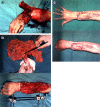Current management of the mangled upper extremity
- PMID: 22923227
- PMCID: PMC3479293
- DOI: 10.1007/s00264-012-1638-y
Current management of the mangled upper extremity
Abstract
Mangled describes an injury caused by cutting, tearing, or crushing, which leads to the limb becoming unrecognizable; in essence, there are two treatment options for mangled upper extremities, amputation and salvage reconstruction. With advances in our understanding of human physiology and basic science, and with the development of new fixation devices, modern microsurgical techniques and the possibility of different types of bony and soft tissue reconstruction, the clinical and functional outcomes are often good, and certainly preferable to those of contemporary prosthetics. Early or even immediate (emergency) complete upper extremity reconstruction appears to give better results than delayed or late reconstruction and should be the treatment of choice where possible. Before any reconstruction is attempted, injuries to other organs must be excluded. Each step in the assessment and treatment of a mangled extremity is of utmost importance. These include radical tissue debridement, prophylactic antibiotics, copious irrigation with a lavage system, stable bone fixation, revascularization, nerve repair, and soft tissue coverage. Well-planned and early rehabilitation leads to a better functional outcome. Despite the use of scoring systems to help guide decisions and predict outcomes, the decision to reconstruct or to amputate still ultimately lies with the surgical judgment and experience of the treating surgeon.
Figures


References
-
- Covey DC. Blast and fragment injuries of the musculoskeletal system. J Bone Joint Surg Am. 2002;84A(7):1221–34. - PubMed
-
- Heller L, Levin S. In: Bone and soft tissue reconstruction in “Rockwood and Green’s fractures in adults”. 6. Bucholz RW, Heckman JD, Court-Brown C, editors. Philadelphia: Lippincott Co; 2006. pp. 497–547.
Publication types
MeSH terms
LinkOut - more resources
Full Text Sources
Medical

